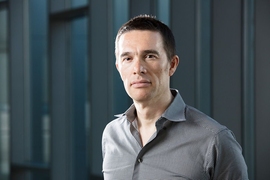Should business leaders spend more time asking questions? Hal Gregersen has a firm answer to that: Yes. Gregersen, the executive director of the MIT Leadership Center and a senior lecturer on leadership and innovation at the MIT Sloan School of Management, has been studying executives for decades. Time and again, he has noticed, the most successful managers are among the most inquisitive people in business. Now Gregersen has synthesized his observations on the subject in a new book, “Questions Are the Answer: A Breakthrough Approach to Your Most Vexing Problems at Work and in Life,” published by HarperCollins. MIT News sat down with Gregersen to, well, ask him about the new book.
Q: What’s the genesis of this book?
A: As I’ve interacted with people, it’s been obvious that finding and asking the right questions was central to the work they did as leaders.
Now, for every leader in any domain — including at the MIT CFO conference where I just spoke — you can ask them, “Is asking questions crucial to your work as a leader?” And it’s head-bobbing time: “Oh yeah.” Then you say, “Turn to the person sitting next to you and explain in 30 seconds what they should do in order to ask better questions.” People will stumble through the answer.
And then I ask, “Okay, how many of you have a high confidence level in the answer you just gave to the person next to you?” And I never see more than 5 percent of the hands go up. Never, ever, all over the world. There’s always this really awkward silence in the room.
So asking questions is this thing that we intuitively sense is important, but we behaviorally discount as being important in our everyday routines.
Q: In that case, how do you get people asking more questions in the workplace?
A: Someone has to care enough about something: What do we care about that we’re trying to get a solution to, but we’re honestly stuck on? To me that’s the starting point. Start really local, really small, and in their [the employees’] space. What’s a challenge they’re facing? What consistently keeps them from making progress?
What we’re doing, especially in a place that’s full of fear, is inviting people to be a little more vulnerable and to solve a problem that will help them make progress. All of us want to leave work at the end of the day feeling that we’ve made progress.
Q: What are the inhibitions that keep us from doing this more often, then?
A: In a world demanding high performance, we’re expected to be at the top of the learning curve and show that we know what we’re doing. That’s the way in which we get hired and promoted at organizations — it’s mostly about having the best answer in the room.
But as we start moving to the edge of uncertainty when tackling wicked, complex problems — and such problems go with senior leadership territory — the problems are no longer given. You have to find them by asking the right questions. And it’s in that space that answer-centered people or leaders end up hitting the wall. Because questions are the only way to open up and work through extreme uncertainty.
Q: You recommend a kind of group brainstorming session you call a “question burst” — two minutes to lay out a problem, four minutes for the group to come up with questions about it, then time for “unpacking” questions to see which help most. Why does this work?
A: It’s sounds so gimmicky and management technique-y, but the data in the book [are] consistent. [At least 80 percent of the time, over 1,500 participants have said the sessions produce useful questions and potential answers for them.] It starts moving people emotionally to a better place. You’re forced to be reflectively quiet. And the toughest question you can ask of the person sitting next to you is the greatest gift you can give them. In short, this method creates the right conditions where people are often wrong, uncomfortable, and quiet, because that’s when the best questions surface to help solve our most vexing challenges.
Q: Are people in business more open to some of these ideas and approaches now, compared to when you started rolling them out?
A: There’s been an enormous move … especially with the digital transformation that is causing companies to completely rethink their business models. In that space, there are a lot of unsettled emotions and ideas among senior leaders about what to do. Many of these organizations have a history of grand success, and now they’re plunging into the sharp edge of uncertainty. So the challenge opens them up to [acknowledging], “I don’t quite know what to do here. I don’t know what I don’t know, and maybe questions are the answer.” Which often feels deeply counterintuitive if they’ve spent most of their lives dishing out answers.
Q: Okay, what questions are you asking these days?
A: Where this book is taking me [now] is smack dab in the middle of AI [artificial intelligence], deep learning, machine learning. … AI currently struggles to make clear sense of ambiguous data when operating beyond the bounds of frameworks it was trained to know. And that’s exactly what we’re doing as human beings when we’re asking catalytic questions that challenge fundamental assumptions, to energize new paths of action. So the first step for my next research project is: How can we harness the power of AI, deep learning, and machine learning, to ask better questions as human beings? I believe that we must figure out ways to do that better and better. AI is not science fiction; it’s here. How can we as human beings keep our questioning capacity alive, vibrant, growing, stronger, adaptive, and inclusive of all this amazing work going on in the tech world, so that AI doesn’t ultimately outpace our human capacity to ask the better question?









